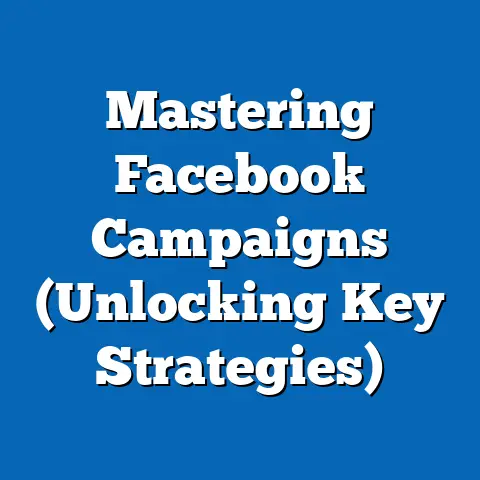Maximize Reach with the Facebook Impressions Calculator (Essential Guide)
Maximize Reach with the Facebook Impressions Calculator: An Essential Guide
Life moves fast, doesn’t it? Between managing a business, keeping up with the latest trends, and trying to maintain some semblance of a personal life, it feels like there’s never enough time in the day. That’s why, as business owners and marketers, we’re constantly on the hunt for efficient and effective advertising solutions. We need tools that can help us maximize our outreach without adding to the already overwhelming demands on our schedules.
That’s where Facebook advertising comes in. It’s a powerhouse for businesses of all sizes, offering unparalleled targeting capabilities and a massive audience reach. But simply throwing money at Facebook ads isn’t a guaranteed recipe for success. You need a strategy, a plan, and the right tools to guide you.
One such tool, often overlooked, is the Facebook Impressions Calculator. It’s not the flashiest feature, but it’s a critical piece of the puzzle when it comes to optimizing your ad performance and making the most of your advertising budget.
Think of the Impressions Calculator as your crystal ball for Facebook ads. It helps you estimate the potential reach and impressions you can expect from your campaigns, allowing you to make informed decisions about your budget, targeting, and ad creative. It helps answer the fundamental question: “If I spend X, will I reach enough of the right people?”
Understanding Impressions and Reach
Before we jump into the specifics of the Impressions Calculator, let’s establish a solid understanding of two key metrics: impressions and reach. These terms are often used interchangeably, but they represent distinct aspects of your ad’s performance.
- Impressions: An impression is counted each time your ad is displayed to a user, regardless of whether they click on it or not. Think of it as the number of times your ad is “seen.” One person can see your ad multiple times, generating multiple impressions.
-
Reach: Reach, on the other hand, represents the total number of unique individuals who have seen your ad. This metric tells you how many different people you’ve exposed your message to.
-
Engagement: Engagement encompasses all the ways people interact with your ad, including likes, comments, shares, saves, and clicks. High engagement signals that your ad resonates with your audience.
Reach: Reach, on the other hand, represents the total number of unique individuals who have seen your ad. This metric tells you how many different people you’ve exposed your message to.
Engagement: Engagement encompasses all the ways people interact with your ad, including likes, comments, shares, saves, and clicks. High engagement signals that your ad resonates with your audience.
Why are both metrics critical?
Both impressions and reach are essential for understanding the effectiveness of your ad campaigns.
- Impressions help you gauge the overall visibility of your ad. A high number of impressions suggests that your ad is being shown frequently, which is important for brand awareness and recall. However, a high number of impressions without a corresponding increase in reach might indicate that you’re showing your ad too many times to the same people, potentially leading to ad fatigue.
- Reach tells you how many unique individuals you’re connecting with. A broad reach is crucial for expanding your audience and attracting new customers. However, a large reach without sufficient engagement might suggest that your ad isn’t resonating with your target audience or that your targeting is too broad.
I remember one campaign I ran for a local bakery. We initially focused on impressions, aiming for maximum visibility within a small geographic area. We ran the same ad multiple times per day. While we racked up a ton of impressions, we noticed that our reach wasn’t growing proportionally. People were seeing our ad repeatedly, but we weren’t attracting new customers.
We then adjusted our strategy, focusing on expanding our reach by targeting different interest groups within the same geographic area and refreshing our ad creative more frequently. This resulted in a more diverse audience and a significant increase in new customer inquiries.
How Understanding Impressions and Reach Informs Marketing Strategies
Understanding the relationship between impressions and reach can significantly inform your marketing strategies.
- Frequency Cap: Based on your impressions and reach data, you can implement a frequency cap. This setting limits the number of times an individual user sees your ad within a specified period. This prevents ad fatigue and ensures that your message remains fresh and engaging.
- Audience Segmentation: Analyzing the demographics and interests of the users who are seeing your ads can help you refine your audience segmentation. If you notice that a particular demographic group is generating a disproportionately high number of impressions but low engagement, you might consider excluding that group from your targeting.
- Ad Creative Optimization: By tracking the impressions and reach of different ad creatives, you can identify which visuals and messaging resonate most effectively with your target audience. This allows you to optimize your ad creative for maximum impact.
Real-World Examples
- E-commerce: An e-commerce store launching a new product line can use impressions to build brand awareness and reach to attract new customers. By tracking the performance of different ad creatives, they can identify which products are generating the most interest and optimize their campaigns accordingly.
- Local Services: A local service provider, such as a plumber or electrician, can use impressions to ensure that their ads are seen frequently by potential customers in their service area. By tracking reach, they can ensure that they’re connecting with a diverse range of homeowners and businesses.
- B2B: A B2B company can use impressions to target specific industry professionals and reach to expand their network of potential clients. By tracking engagement metrics, they can identify which content is most relevant to their target audience and optimize their messaging accordingly.
Key Takeaways:
- Impressions represent the number of times your ad is displayed, while reach represents the number of unique individuals who have seen your ad.
- Both metrics are critical for understanding the effectiveness of your ad campaigns.
- Understanding the relationship between impressions and reach can inform your marketing strategies, including frequency capping, audience segmentation, and ad creative optimization.
Next Steps:
- Start tracking your impressions and reach metrics in your Facebook ad campaigns.
- Analyze the relationship between these metrics to identify areas for improvement.
- Experiment with different targeting options, ad creatives, and frequency caps to optimize your ad performance.
The Importance of the Facebook Impressions Calculator
Now that we’ve established a firm grasp on impressions and reach, let’s delve into the functionality and importance of the Facebook Impressions Calculator.
The Facebook Impressions Calculator is a tool within the Facebook Ads Manager that allows you to estimate the potential reach and impressions you can expect from your ad campaigns. It’s like a sneak peek into the future, providing you with valuable insights before you even launch your ad.
How the Calculator Works
The Impressions Calculator takes into account several key variables to generate its estimates:
- Budget: The amount of money you’re willing to spend on your ad campaign.
- Duration: The length of time your ad campaign will run.
- Target Audience: The demographics, interests, and behaviors of the people you’re targeting with your ad.
- Ad Placement: Where your ad will be displayed on Facebook and Instagram (e.g., news feed, stories, right column).
- Bidding Strategy: How you’re bidding for ad placements (e.g., automatic bidding, manual bidding).
Based on these inputs, the calculator estimates the potential reach and impressions you can expect to achieve. It also provides a range of potential outcomes, taking into account factors such as ad quality, competition, and user behavior.
Why is this tool so important?
- Budget Planning: The Impressions Calculator helps you determine how much you need to spend to reach your target audience. This allows you to allocate your budget effectively and avoid overspending or underspending.
- Audience Sizing: The calculator can help you assess whether your target audience is too broad or too narrow. If the estimated reach is too low, you might consider broadening your targeting criteria. If the estimated reach is too high, you might consider narrowing your targeting to focus on the most relevant users.
- Ad Placement Optimization: By experimenting with different ad placements in the calculator, you can identify the most effective placements for reaching your target audience.
- Realistic Expectations: The Impressions Calculator helps you set realistic expectations for your ad campaigns. It provides a sense of what’s achievable with your budget and targeting, preventing you from being disappointed by underwhelming results.
I’ve personally used the Impressions Calculator to help clients set realistic expectations and avoid overspending on their Facebook ad campaigns. In one instance, a client was convinced that they needed to spend a significant amount of money to reach their target audience. However, after using the Impressions Calculator, we discovered that they could achieve their desired reach with a much smaller budget by refining their targeting and optimizing their ad creative.
Testimonials and Case Studies
While I can’t reveal specific client names, I can share some anonymized testimonials and case studies:
- “The Impressions Calculator helped us understand how much we needed to spend to reach our target audience. It prevented us from overspending and allowed us to allocate our budget more effectively.” – E-commerce Business Owner
- “We were initially targeting a very broad audience, but the Impressions Calculator showed us that we could achieve better results by narrowing our targeting and focusing on the most relevant users.” – Local Service Provider
- “The Impressions Calculator helped us identify the most effective ad placements for reaching our target audience. We were able to optimize our campaigns and improve our ROI.” – B2B Marketing Manager
Key Takeaways:
- The Facebook Impressions Calculator is a tool that estimates the potential reach and impressions of your ad campaigns.
- It takes into account factors such as budget, duration, target audience, ad placement, and bidding strategy.
- The calculator helps you with budget planning, audience sizing, ad placement optimization, and setting realistic expectations.
Next Steps:
- Start using the Facebook Impressions Calculator to estimate the potential reach and impressions of your ad campaigns.
- Experiment with different variables to see how they impact the estimated results.
- Use the calculator to inform your budget planning, audience sizing, and ad placement decisions.
Step-by-Step Guide to Using the Facebook Impressions Calculator
Now, let’s get practical. I’m going to walk you through a detailed, step-by-step guide on how to access and utilize the Facebook Impressions Calculator.
Step 1: Accessing the Calculator Through Facebook Ads Manager
- Log in to your Facebook Ads Manager account. This is the central hub for managing all your Facebook ad campaigns.
- Navigate to the “Audiences” section. You can find this in the left-hand menu.
- Create a new audience or select an existing one. If you’re creating a new audience, define your target demographics, interests, and behaviors. The more specific you are, the more accurate the Impressions Calculator will be.
- Click on the “Estimate Audience Size” button. This will open the Impressions Calculator.
Step 2: Inputting Budget and Duration of the Campaign
- Enter your daily or lifetime budget. This is the amount of money you’re willing to spend on your ad campaign each day or over its entire duration.
- Specify the start and end dates of your campaign. This determines the duration of your ad campaign.
Step 3: Selecting Target Audience Demographics and Interests
- Review your selected audience demographics. Ensure that your targeting is aligned with your ideal customer profile.
- Add or refine your audience interests. This allows you to target users who have expressed interest in specific topics, products, or brands.
- Consider using detailed targeting options. This allows you to target users based on their behaviors, demographics, and interests in a highly specific way.
Step 4: Analyzing the Output Data for Impressions and Reach
- Review the estimated daily reach and impressions. The Impressions Calculator will display a range of potential outcomes, taking into account factors such as ad quality, competition, and user behavior.
- Pay attention to the estimated cost per result. This metric tells you how much you can expect to pay for each desired outcome (e.g., website visit, lead, purchase).
- Consider the estimated conversion rate. This metric tells you the percentage of users who are likely to take the desired action after seeing your ad.
Interpreting the Results
The results from the Impressions Calculator provide valuable insights into the potential performance of your ad campaign.
- High Estimated Reach and Impressions: This suggests that your target audience is large and that your ad has the potential to be seen by a significant number of people. However, it’s important to ensure that your ad is relevant to your target audience and that your messaging is compelling.
- Low Estimated Reach and Impressions: This suggests that your target audience is too small or that your targeting is too narrow. You might consider broadening your targeting criteria or exploring new audience segments.
- High Estimated Cost Per Result: This suggests that your ad is not resonating with your target audience or that your bidding strategy is not optimized. You might consider refining your ad creative, adjusting your bidding strategy, or exploring new targeting options.
- Low Estimated Conversion Rate: This suggests that your ad is not effectively driving the desired action. You might consider optimizing your landing page, improving your call to action, or refining your ad creative.
Tips for Accuracy
- Use a specific target audience. The more specific you are with your targeting, the more accurate the Impressions Calculator will be.
- Accurately estimate your budget and duration. These variables have a significant impact on the estimated reach and impressions.
- Consider the seasonality of your business. Ad performance can fluctuate based on the time of year.
- Factor in competition. If there are many other advertisers targeting the same audience, your reach and impressions may be lower.
Key Takeaways:
- Access the Impressions Calculator through Facebook Ads Manager.
- Input your budget, duration, and target audience information.
- Analyze the output data for impressions, reach, cost per result, and conversion rate.
- Interpret the results to inform your budget planning, audience sizing, and ad creative decisions.
Next Steps:
- Practice using the Impressions Calculator with different scenarios.
- Experiment with different targeting options, budget levels, and ad placements.
- Track the actual performance of your ad campaigns and compare it to the estimated results.
Real-Life Applications and Strategies
The Facebook Impressions Calculator isn’t just a theoretical tool; it’s a practical resource that can be leveraged by different types of businesses for their unique advertising needs. Let’s explore some real-life applications and strategies:
E-commerce
- Scenario: An e-commerce store is launching a new product line and wants to generate awareness and drive sales.
- How to Use the Impressions Calculator:
- Use the calculator to estimate the potential reach and impressions of different ad campaigns targeting different customer segments (e.g., existing customers, potential customers, interest-based targeting).
- Compare the estimated cost per result for different campaigns and allocate budget accordingly.
- Use the calculator to determine the optimal ad placement for reaching the target audience (e.g., news feed, stories, right column).
- Tailoring Ad Content: Based on the calculated impressions and expected reach, tailor ad content to resonate with the target audience. For example, if the target audience is young adults, use trendy visuals and messaging. If the target audience is older adults, use more traditional visuals and messaging.
- Use the calculator to estimate the potential reach and impressions of different ad campaigns targeting different customer segments (e.g., existing customers, potential customers, interest-based targeting).
- Compare the estimated cost per result for different campaigns and allocate budget accordingly.
- Use the calculator to determine the optimal ad placement for reaching the target audience (e.g., news feed, stories, right column).
Local Services
- Scenario: A local service provider, such as a plumber or electrician, wants to generate leads and attract new customers in their service area.
- How to Use the Impressions Calculator:
- Use the calculator to estimate the potential reach and impressions of ad campaigns targeting homeowners and businesses within a specific geographic radius.
- Compare the estimated cost per lead for different campaigns and allocate budget accordingly.
- Use the calculator to determine the optimal ad schedule for reaching the target audience (e.g., weekdays, weekends, evenings).
- Tailoring Ad Content: Focus on highlighting the benefits of the service, such as reliability, affordability, and expertise. Include testimonials from satisfied customers and offer special promotions to incentivize action.
- Use the calculator to estimate the potential reach and impressions of ad campaigns targeting homeowners and businesses within a specific geographic radius.
- Compare the estimated cost per lead for different campaigns and allocate budget accordingly.
- Use the calculator to determine the optimal ad schedule for reaching the target audience (e.g., weekdays, weekends, evenings).
B2B
- Scenario: A B2B company wants to generate leads and build relationships with potential clients in their industry.
- How to Use the Impressions Calculator:
- Use the calculator to estimate the potential reach and impressions of ad campaigns targeting specific industry professionals and decision-makers.
- Compare the estimated cost per lead for different campaigns and allocate budget accordingly.
- Use the calculator to determine the optimal ad format for reaching the target audience (e.g., lead generation ads, video ads, carousel ads).
- Tailoring Ad Content: Focus on providing valuable insights and solutions to the target audience’s challenges. Offer free resources, such as white papers, webinars, and case studies, to build trust and credibility.
- Use the calculator to estimate the potential reach and impressions of ad campaigns targeting specific industry professionals and decision-makers.
- Compare the estimated cost per lead for different campaigns and allocate budget accordingly.
- Use the calculator to determine the optimal ad format for reaching the target audience (e.g., lead generation ads, video ads, carousel ads).
The Interaction Between Impressions and Ad Quality
It’s crucial to remember that impressions are just one piece of the puzzle. The quality of your ad plays a significant role in determining its effectiveness.
- Relevance: Your ad should be relevant to the interests and needs of your target audience.
- Engagement: Your ad should be engaging and visually appealing, capturing the attention of users as they scroll through their news feeds.
- Value: Your ad should offer value to the user, whether it’s a solution to a problem, a discount on a product, or valuable information.
Facebook’s algorithm rewards high-quality ads with lower costs and higher reach. Therefore, it’s essential to focus on creating ads that are not only seen but also resonate with your target audience.
Combining the Impressions Calculator with Other Facebook Advertising Tools
The Impressions Calculator is a valuable tool on its own, but it becomes even more powerful when combined with other Facebook advertising tools:
- Audience Insights: This tool provides detailed information about your target audience, including their demographics, interests, behaviors, and purchase habits. Use this information to refine your targeting and create more relevant ads.
- A/B Testing: This allows you to test different versions of your ad creative, targeting options, and bidding strategies to identify what works best. Use A/B testing to optimize your campaigns for maximum performance.
- Facebook Pixel: This code snippet tracks the actions that users take on your website after clicking on your ad. Use this data to measure the effectiveness of your campaigns and optimize your targeting and ad creative.
Key Takeaways:
- Different types of businesses can leverage the Impressions Calculator for their unique advertising needs.
- Tailor ad content based on calculated impressions and expected reach.
- The quality of your ad plays a significant role in determining its effectiveness.
- Combine the Impressions Calculator with other Facebook advertising tools for a more robust strategy.
Next Steps:
- Identify how the Impressions Calculator can be applied to your specific business needs.
- Tailor your ad content to resonate with your target audience.
- Focus on creating high-quality ads that are relevant, engaging, and valuable.
- Combine the Impressions Calculator with other Facebook advertising tools to optimize your campaigns.
Common Mistakes to Avoid
While the Facebook Impressions Calculator is a powerful tool, it’s important to be aware of common mistakes that advertisers make when using it. Avoiding these pitfalls can help you ensure that you’re getting the most accurate estimates and making informed decisions.
Relying Solely on Impressions Without Considering Engagement Metrics
It’s tempting to focus solely on impressions, aiming for maximum visibility. However, impressions alone don’t tell the whole story. If your ads are generating a lot of impressions but not driving engagement (likes, comments, shares, clicks), it’s a sign that your ads aren’t resonating with your target audience.
- The Problem: High impressions without engagement indicate that your ads are being seen, but they’re not capturing the attention or interest of users. This can lead to wasted ad spend and ineffective campaigns.
- The Solution: Focus on creating engaging and visually appealing ads that capture the attention of your target audience. Use compelling headlines, high-quality images or videos, and clear calls to action.
Miscalculating Audience Size or Budget Allocation
Accurately estimating your audience size and budget allocation is crucial for getting accurate results from the Impressions Calculator.
- The Problem: If you underestimate your audience size, the calculator may overestimate the reach and impressions you can achieve with your budget. If you overestimate your audience size, the calculator may underestimate the reach and impressions you can achieve.
- The Solution: Use Facebook’s Audience Insights tool to get a more accurate understanding of your target audience’s demographics, interests, and behaviors. Use the Impressions Calculator to experiment with different budget levels and see how they impact the estimated reach and impressions.
Ignoring Ad Fatigue
Ad fatigue occurs when users become tired of seeing the same ad repeatedly. This can lead to decreased engagement and lower click-through rates.
- The Problem: If you don’t address ad fatigue, your ad performance will decline over time, even if your initial results were strong.
- The Solution: Rotate your ad creative frequently to keep your ads fresh and engaging. Use Facebook’s frequency capping feature to limit the number of times an individual user sees your ad within a specified period.
Ignoring Seasonality and Trends
Ad performance can fluctuate based on the time of year, holidays, and current trends.
- The Problem: If you don’t factor in seasonality and trends, your ad performance may be lower than expected during certain times of the year.
- The Solution: Plan your ad campaigns in advance, taking into account seasonality and trends. Use Facebook’s targeting options to target users based on their interests in specific events or holidays.
Key Takeaways:
- Don’t rely solely on impressions without considering engagement metrics.
- Accurately calculate your audience size and budget allocation.
- Address ad fatigue by rotating your ad creative and using frequency capping.
- Factor in seasonality and trends when planning your ad campaigns.
Next Steps:
- Review your current Facebook ad campaigns and identify any potential mistakes you’re making.
- Implement the solutions outlined in this section to improve your ad performance.
- Continuously monitor your ad campaigns and make adjustments as needed.
Conclusion
The Facebook Impressions Calculator is a powerful tool that can help you maximize your reach and achieve better results with your Facebook advertising campaigns. By understanding how the calculator works, avoiding common mistakes, and combining it with other Facebook advertising tools, you can make informed decisions about your budget, targeting, and ad creative.
Remember, the key to successful Facebook advertising is to focus on creating high-quality ads that are relevant, engaging, and valuable to your target audience. By leveraging the Impressions Calculator and other tools, you can ensure that your ads are seen by the right people at the right time, driving meaningful results for your business.
I encourage you to take actionable steps using the Impressions Calculator to refine your Facebook advertising strategies and achieve better results. Don’t be afraid to experiment with different variables, test new approaches, and continuously monitor your ad performance. With a strategic approach and a commitment to optimization, you can unlock the full potential of Facebook advertising and achieve your business goals.
So, go ahead, fire up the Facebook Ads Manager, and start exploring the power of the Impressions Calculator. Your next successful ad campaign awaits!






